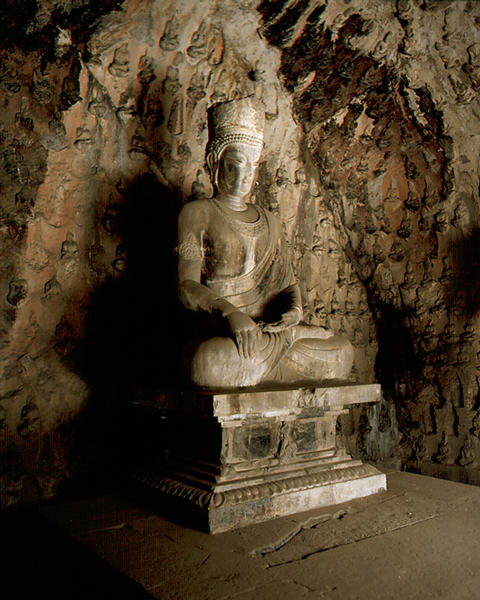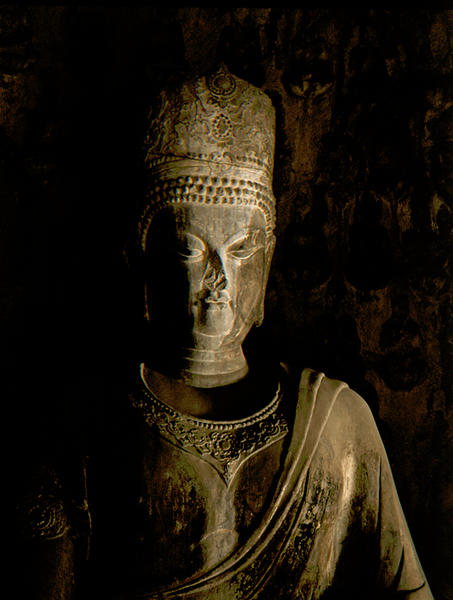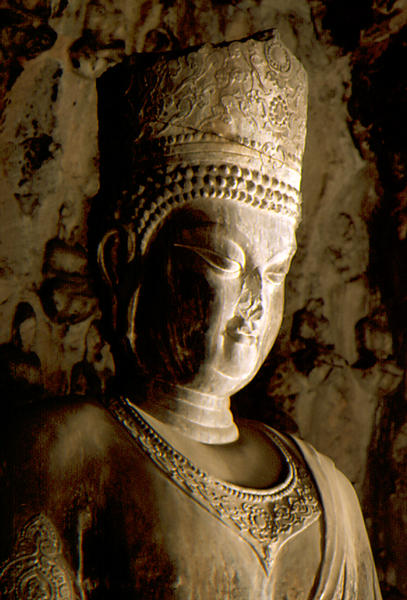宝冠如来坐像
- 擂鼓台南洞
- 唐時代
- 石灰石
- H-240
- 所蔵
- 龍門石窟研究所蔵
石灰石/擂鼓台南洞 唐時代/像高240.0 cm/龍門石窟研究所蔵
いつの頃からか定かではないが、擂鼓台南洞の中央須弥壇上に安置されている。頭部に螺[ら]髪[ほつ]を表す如来像でありながら、宝珠と雲をあしらった宝冠を戴き、華麗な装飾の胸飾り、右手には臂[ひ]釧[せん]を着けている。偏[へん]袒[たん]右[う]肩[けん]に着けた衣に包んだ左手を腹前に置き、右手を下げて膝上に伏せた状態で5指を伸ばし、方形の台座の上に右足を前に結跏趺坐している。この種の宝冠如来像は擂鼓台北洞の正壁像をはじめ、東京国立博物館所蔵の西安宝慶寺請来の浮彫像や、四川省広[こう]元[げん]千[せん]仏[ぶつ]崖[がい]の先天元年(712)銘の菩提瑞像などに見られる。大日如来とも呼ばれているが、釈迦が悟りを開いた瞬間を表す瑞像であろうとの説もある。鼻先と両手の指先に破損が見られるものの、面長で、やや吊り上がり気味の目をした厳しい表情、背筋を伸ばす上体に、足部をやや窮屈そうに組んだ造形は、図版35の肩幅が広く伸びやかな姿態や薄い着衣を透かして中の肉体が見えるようなインド的な表現に比べれば、はるかに中国化した感がある。
Catalogue Entry
Limestone/ Leigutainandong Cave, Tang dynasty/ Fig. H. 240.0 cm/
Longmen Caves Research Institute
While the date of placement in its current location is not certain, this sculpture now is installed on the central dais in the Leigutainandong Cave. The figure's head is topped with a crown covered in jewels and auspicious clouds, the chest of the figure shows a splendidly decorated chest ornament, and the right upper arm has a decorative arm band. The right hand lies on the right leg with all five fingers extended. The right shoulder is bared and the robe wraps around the left shoulder and left arm. The left hand rests on the figure's lap in front of the abdomen with all five fingers are extended. The figure is seated on a square dais with legs folded in padmasana pose with right foot in front. This type of crowned Buddha image can be also found on the main wall of the Leigutaibeidong Cave, in a relief-carved image from Xian Baoqingsi now in the Tokyo National Museum collection, and in the figure of Sakyamuni under the Bodhi Tree inscribed with a date of Xiantian 1 (712) on the Guangyang Qianfoya Cliff in Sichuan province. This iconographic type is often called Mahavairocana. However there is also a theory that the figure is Sakyamuni at the instant of enlightenment. The tip of the nose and the fingers of both hands show breakage. The face is elongated, the eyes are slightly raised at the outside corners, and the face has a dignified appearance overall. The figure's back is straight and elongated, and the small feet are somewhat cramped while the knees are spread wide. This figural type reflects a clear Sinicization of the Indian style, seen at cat. No. 35, with its broad shoulders, sinuous body form, and body visible through thin drapery.


